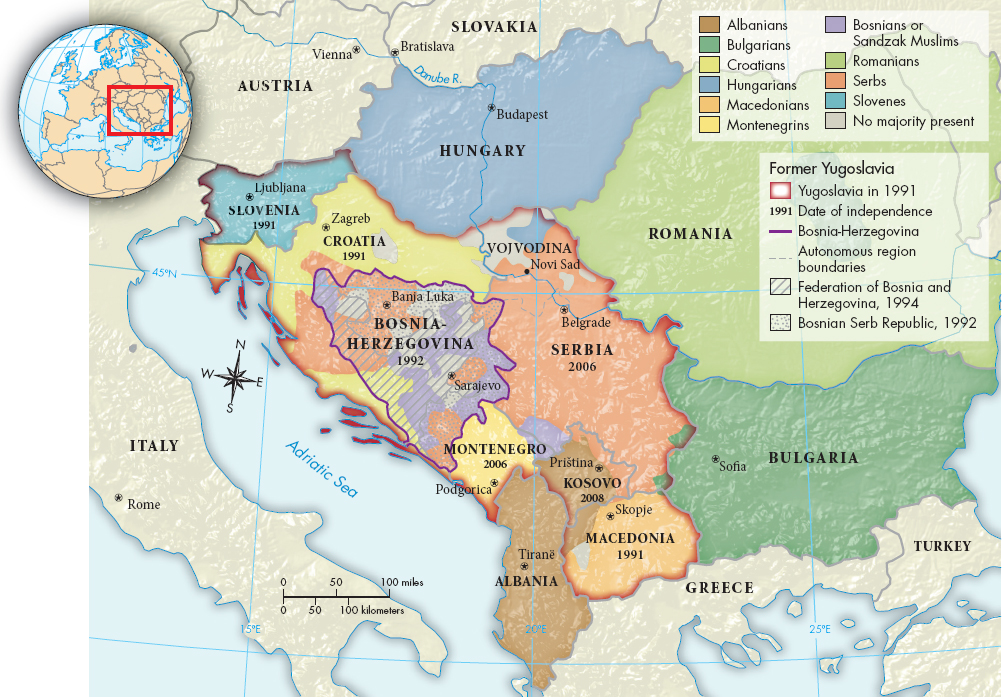Tragedy in Yugoslavia
The great postcommunist tragedy was Yugoslavia, which, under Josip Broz Tito, had been a federation of republics under centralized Communist rule (see "Postwar Life in the East Bloc" in Chapter 28). After Tito’s death in 1980, power passed increasingly to the sister republics, which encouraged a revival of centuries-old regional and ethnic conflicts that were exacerbated by charges of ethnically inspired massacres during World War II and a dramatic economic decline in the mid-1980s.
The revolutions of 1989 accelerated the breakup of Yugoslavia. In 1989, Serbian president Slobodan Milošević (SLOH-buh-dayn mee-LOH-sheh-veech) (1941–2006) severely limited self-rule in the Serbian province of Kosovo, where Albanian-speaking, primarily Islamic peoples constituted the overwhelming majority but which held a medieval battleground that he claimed was sacred to Serbian identity. In 1990, Miloševic´ supported calls to grab land from other republics and unite all Serbs, regardless of where they lived, in a “greater Serbia.” Miloševic´’s moves strengthened the cause of national separatism in the federation, and in June 1991, Slovenia and Croatia declared their independence. Miloševic´ ordered the federal army to invade both areas to assert Serbian control. The Serbs were quickly repulsed in Slovenia, but they managed to take about 30 percent of Croatia.
In 1992, the civil war spread to Bosnia-Herzegovina, which had also declared its independence. Serbs — about 30 percent of that region’s population — refused to live under the more numerous Bosnian Muslims, or Bosniaks (Map 30.2). Yugoslavia had once been a tolerant and largely successful multiethnic state with different groups living side by side and often intermarrying. The new goal of the armed factions in the Bosnian civil war was ethnic cleansing, or genocide: the attempt to establish ethnically homogeneous territories by intimidation, forced deportation, and killing. Serbian armies and irregular militias attempted to “cleanse” the territory of its non-Serb residents, unleashing ruthless brutality, with murder, rape, destruction, and the herding of refugees into concentration camps. Before the fighting in Bosnia ended, some three hundred thousand people were dead, and millions had been forced to flee their homes.

MAP 30.2
The Breakup of Yugoslavia, 1991–2006 Yugoslavia had the most ethnically diverse population in eastern Europe. The republic of Croatia had substantial Serbian and Muslim minorities. Bosnia-Herzegovina had large Muslim, Serbian, and Croatian populations, none of which had a majority. In June 1991, Serbia’s brutal effort to seize territory and unite all Serbs in a single state brought a tragic civil war.
The Western nations had difficulty formulating an effective, unified response to this appalling violence. The turning point came in July 1995 when Bosnian Serbs overran Srebrenica — a Muslim city previously declared a United Nations safe area. Serb forces killed about eight thousand of the city’s Bosniak civilians, primarily men and boys. Public outrage prompted NATO to bomb Bosnian Serb military targets intensively, and the Croatian army drove all the Serbs from Croatia. In November 1995, U.S. President Bill Clinton helped the warring sides hammer out a complicated accord. Troops from NATO countries patrolled Bosnia to keep the peace; by 2013, only one thousand NATO troops remained, suggesting that the situation had significantly improved.
The Albanian Muslims of Kosovo, who hoped to establish self-rule, gained nothing from the Bosnian agreement. Frustrated Kosovar militants formed the Kosovo Liberation Army (KLA) and began to fight for independence. Serbian repression of the Kosovars increased, and in 1998, Serbian forces attacked both KLA guerrillas and unarmed villagers, displacing 250,000 people.
When Miloševic´ refused to withdraw Serbian armies from Kosovo, NATO began bombing Serbia in March 1999. Serbian paramilitary forces responded by driving about 865,000 Albanian Kosovars into exile. NATO redoubled its destructive bombing campaign, which eventually forced Miloševic´ to withdraw and allowed the Kosovars to regain their homeland. A United Nations and NATO peacekeeping force occupied Kosovo, ending ten years of Yugoslavian civil wars.
Which former East Bloc countries fared best after 1989? Which fared worst? Why?
